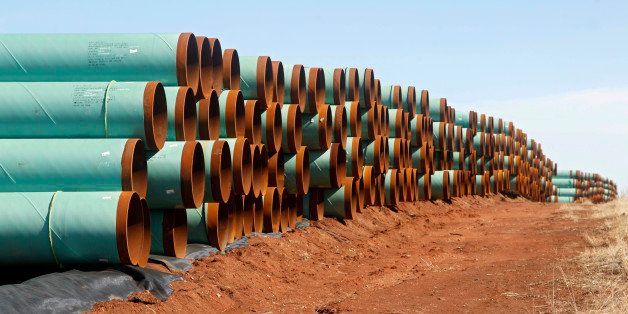
The President's rejection of the Keystone XL tar sands pipeline ushered in a new model of climate leadership--one that carries great significance as we head into the international climate negotiations in Paris later.
Over the past few years, the United States has dramatically expanded its clean energy resources, such as energy efficiency and renewable energy. We are also working hard to cut carbon pollution from our cars, trucks, and power plants. These steps are essential in the fight against climate change. But now there is growing recognition that this battle also requires a different kind of action: saying no to costly infrastructure and leasing projects that would lock us into decades of additional fossil fuel use.
President Obama demonstrated this climate leadership with his Keystone XL announcement. He said, "If we're gonna prevent large parts of this earth from becoming not only inhospitable but uninhabitable in our lifetimes, we're gonna have to keep some fossil fuels in the ground rather than burn them and release more dangerous pollution into the sky."
Whenever we find ourselves at a crossroads, the scale of our climate crisis demands that we choose the clean energy path and reject the dirty fuels dead end. President Obama's choice on Keystone XL added momentum to this push forward. Once you start opposing dirty fuel infrastructure, every decision after it becomes easier.
Climate change is already causing damage to our communities and health. Going into the Paris climate conference later this month, governments around the world are recognizing the urgent need for climate action and making commitments to reduce greenhouse gas emissions. Now is the time to make these choices--especially with so much potential from energy efficiency and the plunging cost of renewable energy.
When NRDC first opposed the Keystone XL pipeline in 2008, many people thought we were crazy to cast it as a climate fight. Yet my colleagues and our many partners knew this was the right course, and we stuck to it. When the industry claimed tar sands oil wasn't that dirty, we presented data showing it generated 17 percent more carbon pollution than conventional fuels. When politicians said tar sands would get to the market with or without Keystone XL, we dug deep and found the industry's own internal assessments that tar sands expansion hinged on the pipeline. And when the Obama administration dragged its heels, we galvanized people of all walks of life to raise their voices to call for rejection of the pipeline.
We kept the heat on, and over time, things shifted. More people sensed the urgent need to act on climate change; now more than two-thirds of Americans favor government limits on carbon pollution. Oil and coal companies have lost their social license to operate as they once did--unfettered and without competition from energy efficiency and renewable energy resources. These and other changes have created the space for political leaders to act.
When President Obama rejected Keystone XL, flanked by Vice President Joe Biden and Secretary of State John Kerry, he said, "If we want to prevent the worst effects of climate change before it's too late, the time to act is now. Not later, not someday. Right here, right now."
The rejection of Keystone XL has defined climate action to include expanding clean energy resources, limiting climate pollution at its source, and preventing new dirty fossil fuel infrastructure.
We need this definition now more than ever. The climate agreement coming out of Paris is expected include a system for strengthening countries' climate pollution reduction targets every five years. This is an essential part of keeping our world at under 2 degrees Celsius of warming. To get there, we will need every tool we have--from clean energy to pollution limits to preventing new carbon-heavy projects from coming online.
President Obama has provided a model for what that kind of climate leadership will look like going forward.
Since President Obama's Keystone XL announcement, I have been savoring the news with fellow campaigners. It's been a seven-year battle, and I have continually found inspiration in this campaign--from the First Nations leaders who showed me the tar sands strip mines to the friends who got arrested with me outside the White House to Nebraskans who came to D.C. to show their deep love of their land and water.
It's gratifying to reflect on all our hard work. We are part of a movement for climate action that is making progress every day.
This post originally appeared on Medium.